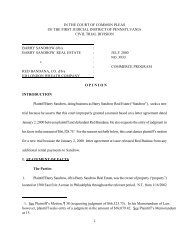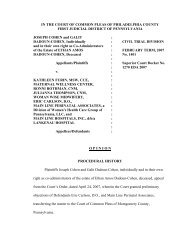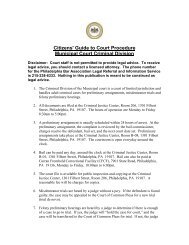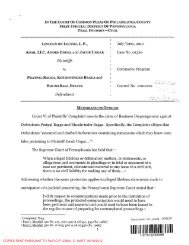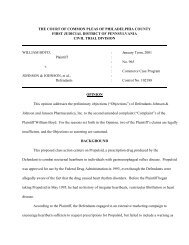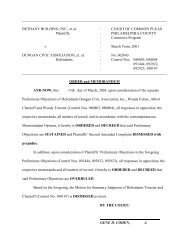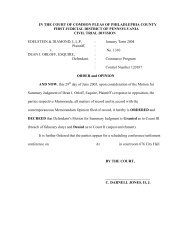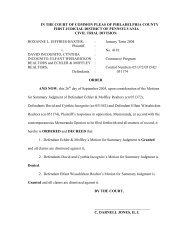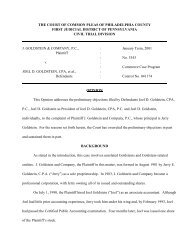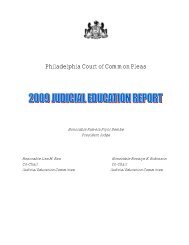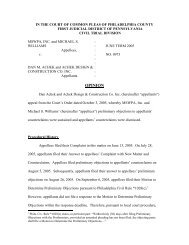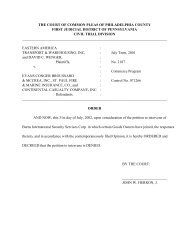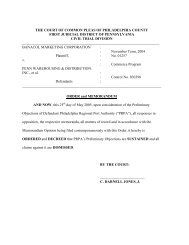in the court of common pleas of philadelphia county first judicial ...
in the court of common pleas of philadelphia county first judicial ...
in the court of common pleas of philadelphia county first judicial ...
Create successful ePaper yourself
Turn your PDF publications into a flip-book with our unique Google optimized e-Paper software.
IN THE COURT OF COMMON PLEAS OF PHILADELPHIA COUNTY<br />
FIRST JUDICIAL DISTRICT OF PENNSYLVANIA<br />
CIVIL TRIAL DIVISION<br />
EGW PARTNERS, L.P., : March Term, 2001<br />
Pla<strong>in</strong>tiff<br />
: No. 0336<br />
v.<br />
:<br />
PRUDENTIAL INSURANCE COMPANY OF AMERICA,<br />
PRUDENTIAL SECURITIES, INCORPORATED : Control No. 042340<br />
Defendants<br />
ORDER<br />
AND NOW, this 22nd day <strong>of</strong> June 2001, upon consideration <strong>of</strong> <strong>the</strong> Prelim<strong>in</strong>ary Objections <strong>of</strong><br />
defendants, Prudential Insurance Company <strong>of</strong> America and Prudential Securities Incorporated, to <strong>the</strong><br />
Compla<strong>in</strong>t <strong>of</strong> pla<strong>in</strong>tiff, EGW Partners, L.P., <strong>the</strong> latter’s response <strong>in</strong> opposition, all matters <strong>of</strong> record, and<br />
after oral argument and <strong>in</strong> accord with <strong>the</strong> Op<strong>in</strong>ion be<strong>in</strong>g filed contemporaneously with this Order, it is<br />
ORDERED that <strong>the</strong> Prelim<strong>in</strong>ary Objections are Overruled. The Defendants are directed to file an<br />
answer to <strong>the</strong> Compla<strong>in</strong>t with<strong>in</strong> twenty-two (22) days <strong>of</strong> <strong>the</strong> date <strong>of</strong> entry <strong>of</strong> this Order.<br />
BY THE COURT:<br />
ALBERT W. SHEPPARD, JR., J.
IN THE COURT OF COMMON PLEAS OF PHILADELPHIA COUNTY<br />
FIRST JUDICIAL DISTRICT OF PENNSYLVANIA<br />
CIVIL TRIAL DIVISION<br />
EGW PARTNERS, L.P., : March Term, 2001<br />
Pla<strong>in</strong>tiff<br />
: No.0336<br />
v.<br />
:<br />
PRUDENTIAL INSURANCE COMPANY OF AMERICA,<br />
PRUDENTIAL SECURITIES, INCORPORATED : Control No. 042340<br />
Defendants<br />
..................................................................................................................................................................<br />
O P I N I O N<br />
Albert W. Sheppard, Jr., J. .................................................................................. June 22, 2001<br />
Defendants, Prudential Insurance Company <strong>of</strong> America (“Insurance”) and Prudential Securities<br />
Incorporated (“Securities”) have filed Prelim<strong>in</strong>ary Objections (“Objections”) to <strong>the</strong> Compla<strong>in</strong>t<br />
(“Compla<strong>in</strong>t”) <strong>of</strong> pla<strong>in</strong>tiff, EGW Partners, L.P. (“EGW”). For <strong>the</strong> reasons set forth, <strong>the</strong> <strong>court</strong> is issu<strong>in</strong>g a<br />
contemporaneous Order (“Order”) overrul<strong>in</strong>g <strong>the</strong> Objections.
BACKGROUND<br />
EGW is a Delaware limited partnership, with Atlas Partners, LLC (“Atlas Partners”) as its general<br />
partner. Beg<strong>in</strong>n<strong>in</strong>g <strong>in</strong> <strong>the</strong> spr<strong>in</strong>g <strong>of</strong> 2000, Jay Eisner (“Eisner”), Atlas Partners’ manag<strong>in</strong>g member and an<br />
EGW partner, met with representatives <strong>of</strong> Securities to organize a private <strong>in</strong>vestment fund. This fund was<br />
<strong>in</strong>tended to orig<strong>in</strong>ate and manage a portfolio <strong>of</strong> high-yield commercial real estate loans and preferred equity<br />
<strong>in</strong>vestments secured by mortgages and o<strong>the</strong>r <strong>in</strong>terests <strong>in</strong> real estate. EGW was particularly <strong>in</strong>terested <strong>in</strong><br />
Securities’ resources and expertise as a market leader, and its sales and real estate <strong>in</strong>vestment bank<strong>in</strong>g staff<br />
which EGW felt could support <strong>the</strong> project on an ongo<strong>in</strong>g basis.<br />
On August 16, 2000, Securities and EGW entered <strong>in</strong>to an agreement under which <strong>the</strong>y would<br />
establish a $200 million <strong>in</strong>vestment fund (“Letter Agreement”). Under <strong>the</strong> terms <strong>of</strong> <strong>the</strong> Letter Agreement,<br />
EGW engaged Securities “as its exclusive agent <strong>in</strong> <strong>the</strong> private placement <strong>of</strong> membership <strong>in</strong>terest or o<strong>the</strong>r<br />
1<br />
equity <strong>in</strong>terest” (“Membership Interests”) <strong>of</strong> Atlas Mezzan<strong>in</strong>e Fund, L.L.C. (“Atlas Fund”). Compla<strong>in</strong>t<br />
Ex. A at 1. The Letter Agreement also provided that Securities would prepare a private placement<br />
memorandum (“PPM”) and a list <strong>of</strong> potential <strong>in</strong>vestors and would assist EGW <strong>in</strong> <strong>of</strong>fer<strong>in</strong>g <strong>the</strong> Membership<br />
Interests and <strong>in</strong> manag<strong>in</strong>g <strong>the</strong> Atlas Fund. In addition, Securities agreed to “use its best efforts to privately<br />
2<br />
place <strong>the</strong> Membership Interests.” Id. at 2(d). These obligations were to be carried out by Securities’<br />
fixed-<strong>in</strong>come sales force (“Sales Force”).<br />
As compensation for its services, Securities was to receive, <strong>in</strong> part, an immediate reta<strong>in</strong>er <strong>of</strong><br />
1 Accord<strong>in</strong>g to <strong>the</strong> Letter Agreement, <strong>the</strong> Atlas Fund was to be a limited liability company or<br />
limited partnership formed by EGW to <strong>in</strong>vest <strong>in</strong> bridge and mezzan<strong>in</strong>e loans on commercial real estate<br />
and structured f<strong>in</strong>ance-related debt securities backed by commercial real estate.<br />
2<br />
The placement <strong>of</strong> <strong>the</strong> Membership Interests is referred to as <strong>the</strong> “Offer<strong>in</strong>g.”<br />
2
3<br />
$125,000 and partnership <strong>in</strong>terests <strong>in</strong> Atlas Partners, EGW and <strong>the</strong> general partner <strong>of</strong> <strong>the</strong> Atlas Fund at<br />
4<br />
<strong>the</strong> Offer<strong>in</strong>g’s clos<strong>in</strong>g. These partnership <strong>in</strong>terests were designed to meet Securities’ purported <strong>in</strong>terest<br />
<strong>in</strong> hav<strong>in</strong>g a long-term relationship with EGW and <strong>in</strong> manag<strong>in</strong>g <strong>the</strong> Atlas Fund. Upon sign<strong>in</strong>g <strong>the</strong> Letter<br />
Agreement, EGW tendered <strong>the</strong> $125,000 reta<strong>in</strong>er.<br />
After <strong>the</strong> Letter Agreement’s execution, EGW and Securities began prepar<strong>in</strong>g <strong>the</strong> PPM.<br />
Accord<strong>in</strong>g to <strong>the</strong> Compla<strong>in</strong>t, EGW expended considerable amounts <strong>of</strong> time and money comply<strong>in</strong>g with <strong>the</strong><br />
Letter Agreement and <strong>the</strong> PPM, <strong>in</strong>clud<strong>in</strong>g hir<strong>in</strong>g a senior vice president and a chief f<strong>in</strong>ancial <strong>of</strong>ficer. EGW<br />
also alleges that it refra<strong>in</strong>ed from pursu<strong>in</strong>g o<strong>the</strong>r opportunities dur<strong>in</strong>g this period due to its exclusive<br />
relationship with Securities. On October 25, 2000, <strong>the</strong> PPM was pr<strong>in</strong>ted, and a presentation to <strong>the</strong> Sales<br />
Force was scheduled for October 30, 2000.<br />
On October 27, 2000, EGW was notified that Securities <strong>in</strong>tended to lay <strong>of</strong>f <strong>the</strong> entire Sales Force.<br />
Three days later, Securities confirmed that <strong>the</strong> last day <strong>of</strong> work for <strong>the</strong> Sales Force would be November<br />
2, 2000. Securities <strong>of</strong>ficials represented that <strong>the</strong> closure <strong>of</strong> <strong>the</strong> department was necessary because it had<br />
been los<strong>in</strong>g money <strong>in</strong> past years. Accord<strong>in</strong>g to <strong>the</strong> Compla<strong>in</strong>t, Insurance had taken over runn<strong>in</strong>g Securities<br />
<strong>in</strong> or before October 2000 when it replaced Securities’ chairman with two Insurance executives.<br />
In spite <strong>of</strong> <strong>the</strong>se lay<strong>of</strong>fs, Richard Schon<strong>in</strong>ger (“Schon<strong>in</strong>ger”), Securities’ head <strong>of</strong> <strong>in</strong>vestment<br />
bank<strong>in</strong>g, met with Eisner on November 1, 2000 with <strong>the</strong> goal <strong>of</strong> salvag<strong>in</strong>g <strong>the</strong> Offer<strong>in</strong>g. Schon<strong>in</strong>ger<br />
allegedly stated to Eisner that Securities and Insurance had put Atlas <strong>in</strong> a “b<strong>in</strong>d,” and proposed hir<strong>in</strong>g<br />
3 Accord<strong>in</strong>g to <strong>the</strong> PPM, <strong>the</strong> name <strong>of</strong> <strong>the</strong> Atlas Fund’s general partner was Atlas SREF, L.P.<br />
4 Securities also was to receive a fee <strong>of</strong> $625,000 at <strong>the</strong> <strong>in</strong>itial clos<strong>in</strong>g <strong>of</strong> <strong>the</strong> Offer<strong>in</strong>g, subject to<br />
reduction to a m<strong>in</strong>imum <strong>of</strong> $375,000, and an additional fee equal to 3 percent <strong>of</strong> certa<strong>in</strong> subscription<br />
commitments, subject to certa<strong>in</strong> reductions.<br />
3
Chadwick Saylor & Co., Inc. (“Chadwick”) as a co-manager to help place <strong>the</strong> Membership Interests.<br />
EGW contends that Schon<strong>in</strong>ger also told Eisner that three Securities employees who had been work<strong>in</strong>g<br />
on placement <strong>of</strong> <strong>the</strong> Membership Interests, <strong>in</strong>clud<strong>in</strong>g Christopher L. Poli (“Poli”), would cont<strong>in</strong>ue do<strong>in</strong>g so<br />
and that all personnel changes would be completed by Thanksgiv<strong>in</strong>g. 5<br />
Soon after his meet<strong>in</strong>g with Schon<strong>in</strong>ger, Eisner participated <strong>in</strong> a conference call with several<br />
Chadwick and Securities employees. Dur<strong>in</strong>g <strong>the</strong> course <strong>of</strong> this call, Poli allegedly stated that Insurance was<br />
likely to start rais<strong>in</strong>g funds <strong>in</strong> early 2001 for Prudential Carbon Mesa (“Carbon Mesa”), an Insurance-<br />
owned real estate structured f<strong>in</strong>ance fund. Accord<strong>in</strong>g to EGW, <strong>the</strong> <strong>of</strong>fer<strong>in</strong>g <strong>of</strong> <strong>in</strong>terests <strong>in</strong> Carbon Mesa<br />
would compete with <strong>the</strong> placement <strong>of</strong> <strong>the</strong> Atlas Fund’s Membership Interests.<br />
On November 28, 2000, Securities <strong>in</strong>formed Eisner that Schon<strong>in</strong>ger was be<strong>in</strong>g forced to leave<br />
Securities by <strong>the</strong> end <strong>of</strong> <strong>the</strong> year. In response, Eisner sent Securities a letter describ<strong>in</strong>g <strong>the</strong> alleged damage<br />
caused by Securities’ failure to market <strong>the</strong> Offer<strong>in</strong>g and <strong>the</strong> elim<strong>in</strong>ation <strong>of</strong> <strong>the</strong> Sales Force. Although EGW<br />
did not receive a response to this letter, Eisner met with two Securities representatives on December 8,<br />
2000. At this meet<strong>in</strong>g, Eisner was told that, even if <strong>the</strong>re were fur<strong>the</strong>r lay<strong>of</strong>fs at Securities, at least one<br />
senior person, probably Poli, would rema<strong>in</strong> assigned to <strong>the</strong> Offer<strong>in</strong>g on a full-time basis and that Chadwick<br />
would be hired to work on market<strong>in</strong>g. By <strong>the</strong> end <strong>of</strong> <strong>the</strong> year, however, even Poli was no longer with<br />
Securities.<br />
Accord<strong>in</strong>g to <strong>the</strong> Compla<strong>in</strong>t, Securities’ restructur<strong>in</strong>g and downsiz<strong>in</strong>g had a number <strong>of</strong> detrimental<br />
effects on <strong>the</strong> Offer<strong>in</strong>g and EGW. First, by virtue <strong>of</strong> <strong>the</strong> term<strong>in</strong>ations at <strong>the</strong> end <strong>of</strong> October, <strong>the</strong> PPM<br />
5 The o<strong>the</strong>r two <strong>in</strong>dividuals were F. Fuller O’Connor, Jr. and John Zakoworotny.<br />
4
ecame <strong>in</strong>accurate and obsolete with<strong>in</strong> days <strong>of</strong> its pr<strong>in</strong>t<strong>in</strong>g. In addition, EGW asserts that Securities has<br />
never engaged <strong>in</strong> any efforts to sell <strong>the</strong> Membership Interests and has not sold any such <strong>in</strong>terests, caus<strong>in</strong>g<br />
a delay <strong>in</strong> complet<strong>in</strong>g <strong>the</strong> Offer<strong>in</strong>g. At <strong>the</strong> same time, EGW was unable to <strong>of</strong>fer <strong>the</strong> Membership Interests<br />
through any o<strong>the</strong>r agent, s<strong>in</strong>ce <strong>the</strong> Engagement Letter provided that Securities’ was EGW’s exclusive agent<br />
for <strong>the</strong> Offer<strong>in</strong>g, while Insurance was free to market <strong>in</strong>terests <strong>in</strong> Carbon Mesa, a competitor <strong>of</strong> <strong>the</strong> Atlas<br />
Fund. On <strong>the</strong> basis <strong>of</strong> <strong>the</strong>se alleged facts, EGW gave notice <strong>of</strong> term<strong>in</strong>ation <strong>of</strong> <strong>the</strong> Engagement Letter on<br />
February 16, 2001.<br />
In its Compla<strong>in</strong>t, EGW asserts causes <strong>of</strong> action for breach <strong>of</strong> contract, <strong>in</strong>tentional misrepresentation<br />
and negligent misrepresentation aga<strong>in</strong>st Securities. EGW also asserts a claim for tortious <strong>in</strong>terference with<br />
contract aga<strong>in</strong>st Insurance. In response, <strong>the</strong> defendants have filed <strong>the</strong> Objections, which contend that<br />
EGW’s claims are legally <strong>in</strong>sufficient and that <strong>the</strong>re is no basis for an award <strong>of</strong> punitive damages.<br />
DISCUSSION<br />
Each <strong>of</strong> <strong>the</strong> Objections contests <strong>the</strong> legal sufficiency <strong>of</strong> EGW’s claims and request for damages.<br />
When a <strong>court</strong> is presented with prelim<strong>in</strong>ary objections assert<strong>in</strong>g legal <strong>in</strong>sufficiency,<br />
[I]t is essential that <strong>the</strong> face <strong>of</strong> <strong>the</strong> compla<strong>in</strong>t <strong>in</strong>dicate that its claims may not be susta<strong>in</strong>ed<br />
and that <strong>the</strong> law will not permit recovery. If <strong>the</strong>re is any doubt, it should be resolved by<br />
<strong>the</strong> overrul<strong>in</strong>g <strong>of</strong> <strong>the</strong> demurrer. Put simply, <strong>the</strong> question presented by demurrer is whe<strong>the</strong>r,<br />
on <strong>the</strong> facts averred, <strong>the</strong> law says with certa<strong>in</strong>ty that no recovery is possible.<br />
Bailey v. Storlazzi, 729 A.2d 1206, 1211 (Pa. Super. Ct. 1999). For <strong>the</strong> purposes <strong>of</strong> review<strong>in</strong>g <strong>the</strong> legal<br />
sufficiency <strong>of</strong> a compla<strong>in</strong>t, “all well-pleaded material, factual averments and all <strong>in</strong>ferences fairly deducible<br />
<strong>the</strong>refrom” are presumed to be true. Tucker v. Philadelphia Daily News, 757 A.2d 938, 941-42 (Pa.<br />
Super. Ct. 2000).<br />
5
I. EGW’s Breach <strong>of</strong> Contract Claim Is Sufficient Because it Alleges a Breach <strong>of</strong> <strong>the</strong><br />
Engagement Letter.<br />
EGW argues that Securities’ failure to use its best efforts to place <strong>the</strong> Membership Interests makes<br />
it liable for breach <strong>of</strong> <strong>the</strong> Engagement Letter. Assum<strong>in</strong>g that <strong>the</strong> allegations <strong>in</strong> <strong>the</strong> Compla<strong>in</strong>t are correct,<br />
<strong>the</strong> <strong>court</strong> agrees.<br />
6<br />
Under New York law, a successful breach <strong>of</strong> contract claim requires evidence <strong>of</strong> an agreement,<br />
consideration, performance by <strong>the</strong> pla<strong>in</strong>tiff and a breach <strong>of</strong> <strong>the</strong> agreement by <strong>the</strong> defendant. Furia v. Furia,<br />
498 N.Y.S.2d 12, 13 (N.Y. App. Div. 1986). Of <strong>the</strong>se elements, Securities challenges only EGW’s<br />
allegations that Securities breached <strong>the</strong> Engagement Letter.<br />
Accord<strong>in</strong>g to <strong>the</strong> terms <strong>of</strong> <strong>the</strong> Engagement Letter, Securities did not guarantee that it would place<br />
<strong>the</strong> Membership Interests but ra<strong>the</strong>r agreed to use its “best efforts” to secure placement. Ex. A at 1,<br />
2(d). The term “best efforts” requires an obligee to “pursue all reasonable methods” to achieve its<br />
objectives and almost <strong>in</strong>variably gives rise to a question <strong>of</strong> fact. Kroboth v. Brent, 625 N.Y.S.2d 748, 749<br />
(N.Y. App. Div. 1995). See also Bloor v. Falstaff Brew<strong>in</strong>g Corp., 601 F.2d 609, 614 (2nd Cir. 1979)<br />
(defendant’s obligation to use its “best efforts” precluded it from rely<strong>in</strong>g on a “philosophy <strong>of</strong> emphasiz<strong>in</strong>g<br />
pr<strong>of</strong>it uber alles without fair consideration <strong>of</strong> <strong>the</strong> effect on” <strong>the</strong> pla<strong>in</strong>tiff); US Airways Group v. British<br />
Airways PLC, 989 F. Supp. 482, 491 (S.D.N.Y. 1997) (stat<strong>in</strong>g that questions as to whe<strong>the</strong>r <strong>the</strong> defendant<br />
used its “best efforts” <strong>in</strong>volved “factual issues that cannot be resolved on <strong>the</strong> face <strong>of</strong> <strong>the</strong> compla<strong>in</strong>t”); Pfizer<br />
Inc. v. PCS Health Sys., Inc., 650 N.Y.S.2d 164, 165 (N.Y. App. Div. 1996) (<strong>the</strong> defendant was still<br />
6 Paragraph 15 <strong>of</strong> <strong>the</strong> Engagement Letter States that it is to be governed by “<strong>the</strong> laws <strong>of</strong> <strong>the</strong><br />
State <strong>of</strong> New York, without regard to its pr<strong>in</strong>ciples <strong>of</strong> conflicts <strong>of</strong> laws.” Compla<strong>in</strong>t Ex. A at 15.<br />
6
ound by its contractual obligations to use its best efforts “even if <strong>the</strong> agreement . . . has became<br />
disadvantageous to defendant”).<br />
In <strong>the</strong> <strong>in</strong>stant matter, <strong>the</strong> Compla<strong>in</strong>t alleges that Securities breached its obligation to use its best<br />
efforts to place <strong>the</strong> Membership Interest and “has engaged <strong>in</strong> no efforts to sell such <strong>in</strong>terests. . . .”<br />
Compla<strong>in</strong>t at 29. This alone is sufficient to susta<strong>in</strong> EGW’s breach <strong>of</strong> contract claim is sufficiently pleaded,<br />
and this Objection is overruled. 7<br />
II. EGW Has Alleged a Special Relationship Between Itself and Securities and May<br />
Proceed on its Negligent Misrepresentation Claim.<br />
Defendants’ argue that pla<strong>in</strong>tiffs’ claim for negligent misrepresentation is defective because <strong>the</strong>re<br />
is no allegation that EGW and Securities had a fiduciary or o<strong>the</strong>r special relationship. This argument is<br />
unpersuasive.<br />
The existence <strong>of</strong> a “special relationship” between a pla<strong>in</strong>tiff and defendant is an essential element<br />
8<br />
<strong>of</strong> a negligent misrepresentation cause <strong>of</strong> action <strong>in</strong> New York. Fab Indus., Inc. v. BNY F<strong>in</strong>. Corp., 675<br />
7 The fact that EGW may have elected to cont<strong>in</strong>ue under <strong>the</strong> contract after Securities’ breach<br />
does not preclude it from br<strong>in</strong>g<strong>in</strong>g a breach <strong>of</strong> contract cause <strong>of</strong> action. See Alesayi Beverage Corp. v.<br />
Canada Dry Corp., 947 F. Supp. 658, 668 (S.D.N.Y. 1996) (“<strong>the</strong> non-breach<strong>in</strong>g party may later sue<br />
for breach, even though it elected to cont<strong>in</strong>ue to perform ra<strong>the</strong>r than term<strong>in</strong>ate <strong>the</strong> agreement, if notice<br />
<strong>of</strong> <strong>the</strong> breach was given to <strong>the</strong> breach<strong>in</strong>g party”). See also Times Mirror Magaz<strong>in</strong>es, Inc. v. Field &<br />
Stream Licenses Co., 103 F. Supp. 2d 711, 736-37 (S.D.N.Y. 2000) (a non-breach<strong>in</strong>g party’s<br />
election to cont<strong>in</strong>ue under a contract does not preclude it from br<strong>in</strong>g<strong>in</strong>g a claim based on <strong>the</strong> breach but<br />
merely forecloses it from term<strong>in</strong>at<strong>in</strong>g <strong>the</strong> contract because <strong>of</strong> <strong>the</strong> breach).<br />
8 The defendants argue fervently and conv<strong>in</strong>c<strong>in</strong>gly that New York law applies to EGW’s tort<br />
claims, but concurrently track <strong>the</strong> application <strong>of</strong> Pennsylvania law <strong>in</strong> footnotes throughout <strong>the</strong>ir<br />
memorandum. EGW does not express an op<strong>in</strong>ion as to which state’s law governs and <strong>in</strong>stead attacks<br />
<strong>the</strong> Objections under both Pennsylvania and New York law. The <strong>court</strong> agrees with EGW that its<br />
claims are susta<strong>in</strong>able under both New York and Pennsylvania law, but has generally followed <strong>the</strong><br />
defendants’ example <strong>of</strong> discuss<strong>in</strong>g New York law <strong>in</strong> <strong>the</strong> body <strong>of</strong> <strong>the</strong> text and Pennsylvania law <strong>in</strong><br />
footnotes.<br />
7
N.Y.S.2d 77, 78 (N.Y. App. Div. 1998). See also Hudson River Club v. Consolidated Edison Co. <strong>of</strong><br />
N.Y., Inc., 712 N.Y.S.2d 104, 106 (N.Y. App. Div. 1996) (negligent misrepresentation claimant must<br />
show “a special relationship <strong>of</strong> trust or confidence, which creates a duty for one party to impart correct<br />
<strong>in</strong>formation to ano<strong>the</strong>r, <strong>the</strong> <strong>in</strong>formation given was false, and <strong>the</strong>re was reasonable reliance upon <strong>the</strong><br />
9<br />
<strong>in</strong>formation given”). Whe<strong>the</strong>r a special relationship has been formed depends on <strong>the</strong> follow<strong>in</strong>g:<br />
In Kimmell <strong>the</strong> Court <strong>of</strong> Appeals held that whe<strong>the</strong>r a special relationship exists<br />
between two parties is an issue <strong>of</strong> fact, to be governed by <strong>the</strong> weigh<strong>in</strong>g <strong>of</strong> three factors:<br />
[A] fact f<strong>in</strong>der should consider whe<strong>the</strong>r <strong>the</strong> person mak<strong>in</strong>g <strong>the</strong><br />
representation held or appeared to hold unique or special expertise;<br />
whe<strong>the</strong>r a special relationship <strong>of</strong> trust or confidence existed between <strong>the</strong><br />
parties; and whe<strong>the</strong>r <strong>the</strong> speaker was aware <strong>of</strong> <strong>the</strong> use to which <strong>the</strong><br />
<strong>in</strong>formation would be put and supplied it for that purpose.<br />
Suez Equity Investors, L.P. v. Toronto-Dom<strong>in</strong>ion Bank, No. 99-9042, 2001 WL 487111, at *11 (2nd<br />
10<br />
Cir. May 8, 2001) (quot<strong>in</strong>g Kimmell v. Schaefer, 675 N.E.2d 450, 454 (N.Y. 1996)). A pr<strong>in</strong>cipal-agent<br />
relationship specifically has been held to constitute a special relationship. West<strong>in</strong>ghouse Elec. Supply Co.<br />
v. Pyramid Champla<strong>in</strong> Co., 597 N.Y.S.2d 811, 814 (N.Y. App. Div. 1993) (pla<strong>in</strong>tiff satisfied <strong>the</strong><br />
9 In total, New York law requires pro<strong>of</strong> <strong>of</strong> four elements to susta<strong>in</strong> a cause <strong>of</strong> action for<br />
negligent misrepresentation:<br />
There must be knowledge, or its equivalent, that <strong>the</strong> <strong>in</strong>formation is desired for a serious<br />
purpose; that he to whom it is given <strong>in</strong>tends to rely and act upon it; that, if false or<br />
erroneous, he will because <strong>of</strong> it be <strong>in</strong>jured <strong>in</strong> person or property. F<strong>in</strong>ally, <strong>the</strong> relationship<br />
<strong>of</strong> <strong>the</strong> parties, aris<strong>in</strong>g out <strong>of</strong> contract or o<strong>the</strong>rwise, must be such that <strong>in</strong> morals and good<br />
conscience <strong>the</strong> one has <strong>the</strong> right to rely upon <strong>the</strong> o<strong>the</strong>r for <strong>in</strong>formation, and <strong>the</strong> o<strong>the</strong>r giv<strong>in</strong>g<br />
<strong>the</strong> <strong>in</strong>formation owes a duty to give it with care.<br />
International Products Co. v. Erie R.R. Co., 155 N.E. 662, 664 (N.Y. 1927).<br />
10 The <strong>court</strong> is puzzled by <strong>the</strong> circuity <strong>of</strong> this statement, <strong>in</strong> that <strong>the</strong> existence <strong>of</strong> a special<br />
relationship depends, <strong>in</strong> part, on whe<strong>the</strong>r a special relationship existed.<br />
8
equirement <strong>of</strong> plead<strong>in</strong>g a special relationship where it alleged <strong>the</strong> existence <strong>of</strong> an agency relationship). 11<br />
The Compla<strong>in</strong>t alleges facts that support f<strong>in</strong>d<strong>in</strong>g a special relationship between EGW and Securities.<br />
Accord<strong>in</strong>g to <strong>the</strong> Compla<strong>in</strong>t, Securities had an “<strong>in</strong>ternational reputation, experience and relationships,” as<br />
well as a “large and experienced fixed-<strong>in</strong>come sales force and <strong>in</strong>vestment bank.” Compla<strong>in</strong>t at 14. These<br />
assets allegedly were buttressed by Securities’ “resources and expertise as a market leader <strong>in</strong> orig<strong>in</strong>at<strong>in</strong>g<br />
and issu<strong>in</strong>g mortgage-backed securities” and “<strong>the</strong> size and strength <strong>of</strong> its parent company, Prudential<br />
Insurance.” Id. at 5. Most significantly, <strong>the</strong> Letter Agreement itself states that Securities was EGW’s<br />
“exclusive agent” <strong>in</strong> <strong>the</strong> placement <strong>of</strong> <strong>the</strong> Membership Interests. Compla<strong>in</strong>t Ex. A at 2(b). Fur<strong>the</strong>rmore,<br />
<strong>the</strong> details <strong>in</strong> <strong>the</strong> PPM and <strong>the</strong> allegations <strong>in</strong> <strong>the</strong> Compla<strong>in</strong>t allow <strong>the</strong> <strong>court</strong> to <strong>in</strong>fer that EGW may have<br />
shared confidential <strong>in</strong>formation with and relied upon Securities, and that Securities was aware <strong>of</strong> EGW’s<br />
dependence on its representations and reputation. Thus, <strong>the</strong> Compla<strong>in</strong>t supports f<strong>in</strong>d<strong>in</strong>g a special<br />
11 Pennsylvania law <strong>in</strong>cludes a similar, if less rigorous, requirement that a defendant owe a<br />
negligent misrepresentation claimant a duty. See, e.g., Gibbs v. Ernst, 538 Pa. 193, 212-13, 647 A.2d<br />
882, 891-92 (1994) (a defendant must have made “reasonable efforts to determ<strong>in</strong>e whe<strong>the</strong>r its<br />
representations are true” and a “duty does not exist if <strong>the</strong> defendant could not reasonably foresee any<br />
<strong>in</strong>jury as <strong>the</strong> result <strong>of</strong> his acts or if his conduct was reasonable <strong>in</strong> light <strong>of</strong> what he could anticipate”).<br />
See also Weisblatt v. M<strong>in</strong>nesota Mut. Life Ins. Co., 4 F. Supp. 2d 371, 380 (E.D. Pa. 1998) (“under<br />
Pennsylvania law, an omission or nondisclosure is only actionable under <strong>the</strong> <strong>the</strong>ory <strong>of</strong> negligent<br />
misrepresentation if <strong>the</strong>re is a duty to speak”). It appears that <strong>the</strong> Pennsylvania requirement <strong>of</strong> a duty<br />
presents a lower threshold than <strong>the</strong> New York requirement <strong>of</strong> a special relationship. See Gibbs, 538<br />
Pa. at 214, 647 A.2d at 892 (hold<strong>in</strong>g that “an adoption agency has a duty to disclose fully and<br />
accurately to <strong>the</strong> adopt<strong>in</strong>g parents all relevant non-identify<strong>in</strong>g <strong>in</strong>formation <strong>in</strong> its possession concern<strong>in</strong>g<br />
<strong>the</strong> adoptee” <strong>in</strong> <strong>the</strong> context <strong>of</strong> a negligent misrepresentation claim). Thus, if EGW satisfies <strong>the</strong> New<br />
York special relationship requirement, <strong>the</strong> Pennsylvania duty requirement will also be satisfied.<br />
The o<strong>the</strong>r elements for a negligent misrepresentation claim <strong>in</strong> Pennsylvania are “a<br />
misrepresentation <strong>of</strong> a material fact; (2) made under circumstances <strong>in</strong> which <strong>the</strong> misrepresenter ought<br />
to have known its falsity; (3) with an <strong>in</strong>tent to <strong>in</strong>duce ano<strong>the</strong>r to act on it; and; (4) which results <strong>in</strong> <strong>in</strong>jury<br />
to a party act<strong>in</strong>g <strong>in</strong> justifiable reliance on <strong>the</strong> misrepresentation.” Kramer v. Dunn, 749 A.2d 984, 991<br />
(Pa. Super. Ct. 2000) (quot<strong>in</strong>g Bortz v. Noon, 556 Pa. 489, 500, 729 A.2d 555, 560 (1999)).<br />
9
elationship between EGW and Securities.<br />
The defendants argue that <strong>the</strong> Compla<strong>in</strong>t’s allegations are negated by Paragraph 17 <strong>of</strong> <strong>the</strong><br />
Engagement Letter, which states that EGW and Securities “do not <strong>in</strong>tend to create any special, fiduciary<br />
or agency relationship between <strong>the</strong>m.” Compla<strong>in</strong>t Ex. A at 17. This provision is <strong>in</strong>consistent with <strong>the</strong><br />
agency relationship established between EGW and Securities <strong>in</strong> Paragraph One <strong>of</strong> <strong>the</strong> Agreement and does<br />
12<br />
present questions as to EGW’s assertion <strong>of</strong> a special relationship between itself and Securities. In <strong>the</strong><br />
context <strong>of</strong> evaluat<strong>in</strong>g <strong>the</strong> Objections, however, <strong>the</strong> <strong>court</strong> must regard EGW’s allegations <strong>of</strong> fact as true and<br />
must conclude that <strong>the</strong> Compla<strong>in</strong>t sets forth sufficiently <strong>the</strong> requisite special relationship. On this basis, <strong>the</strong><br />
Objections to EGW’s negligent misrepresentation claim must be overruled.<br />
III. EGW’s Intentional Misrepresentation Claim is Legally Sufficient.<br />
The defendants next argue that EGW’s <strong>in</strong>tentional misrepresentation claim must be dismissed<br />
13<br />
because it is not sufficiently dist<strong>in</strong>ct from its breach <strong>of</strong> contract claim. Because EGW pleads that<br />
Securities violated a non-contractual duty, however, it may proceed with its <strong>in</strong>tentional misrepresentation<br />
claim.<br />
Pennsylvania and New York require pro<strong>of</strong> <strong>of</strong> substantially identical elements for fraudulent<br />
12 EGW’s argument aga<strong>in</strong>st <strong>the</strong> application <strong>of</strong> Paragraph 17 is premised on <strong>the</strong> assertion that<br />
<strong>the</strong> PPM <strong>in</strong>cluded no such disclaimer and represented that EGW and Securities would become<br />
partners. EGW’s Memorandum at 27. This argument may be bolstered by <strong>the</strong> fact that <strong>the</strong> events<br />
allegedly giv<strong>in</strong>g rise to <strong>the</strong> special relationship between EGW and Securities took place after <strong>the</strong><br />
Engagement Letter was executed.<br />
13 In challeng<strong>in</strong>g EGW’s <strong>in</strong>tentional misrepresentation claim, <strong>the</strong> Defendants also assert that<br />
EGW has failed to allege scienter. At <strong>the</strong> least, however, <strong>the</strong> allegations <strong>of</strong> Securities’ malice and bad<br />
faith set forth <strong>in</strong> <strong>the</strong> Compla<strong>in</strong>t allow <strong>the</strong> <strong>court</strong> to <strong>in</strong>fer <strong>the</strong> requisite scienter.<br />
10
14<br />
misrepresentation. In both jurisdictions, a claim for fraudulent misrepresentation can arise from a failure<br />
to disclose <strong>in</strong>formation. In New York, such a claim must be premised on a special relationship between<br />
<strong>the</strong> parties, St. Patrick’s Home for Aged & Infirm v. Laticrete Int’l, Inc., 696 N.Y.S.2d 117, 124 (N.Y.<br />
App. Div. 1999), while Pennsylvania requires that one party owe <strong>the</strong> o<strong>the</strong>r a duty <strong>of</strong> disclosure. Wilson<br />
v. Donegal Mut. Ins. Co., 410 Pa. Super. 31, 41, 598 A.2d 1310, 1316 (1991). See also Stevenson<br />
Equip., Inc. v. Chemig Construction Corp., 565 N.Y.S.2d 318, 320 (N.Y. App. Div. 1991) (“where one<br />
party possesses superior knowledge, not readily available to <strong>the</strong> o<strong>the</strong>r, and knows that <strong>the</strong> o<strong>the</strong>r is act<strong>in</strong>g<br />
on <strong>the</strong> basis <strong>of</strong> mistaken knowledge, <strong>the</strong>re is a duty to disclose that <strong>in</strong>formation”); Mobil Oil Corp. v. Joshi,<br />
609 N.Y.S.2d 214, 215 (N.Y. App. Div. 1994) (silence is not actionable as fraud “<strong>in</strong> <strong>the</strong> absence <strong>of</strong> a<br />
confidential or fiduciary relationship”); Sewak v. Lockhart, 699 A.2d 755, 759 (Pa. Super. Ct. 1997)<br />
(“mere silence without a duty to speak will not constitute fraud”). As discussed supra, <strong>the</strong> Compla<strong>in</strong>t<br />
asserts facts that establish a special relationship between EGW and <strong>the</strong> Defendants and that support f<strong>in</strong>d<strong>in</strong>g<br />
a duty <strong>of</strong> disclosure on <strong>the</strong> defendants’ part.<br />
This, however, does not end <strong>the</strong> <strong>court</strong>’s <strong>in</strong>quiry. Accord<strong>in</strong>g to <strong>the</strong> defendants, EGW has not pled<br />
any misrepresentations <strong>of</strong> present facts that were collateral to <strong>the</strong> contract and that caused damages not<br />
14 Under New York law, a pla<strong>in</strong>tiff must establish “misrepresentation or a material omission <strong>of</strong><br />
fact which was false and known to be false by defendant, made for <strong>the</strong> purpose <strong>of</strong> <strong>in</strong>duc<strong>in</strong>g <strong>the</strong> o<strong>the</strong>r<br />
party to rely upon it, justifiable reliance <strong>of</strong> <strong>the</strong> o<strong>the</strong>r party on <strong>the</strong> misrepresentation or material omission,<br />
and <strong>in</strong>jury.” Lama Hold<strong>in</strong>g Co. v. Smith Barney Inc., 668 N.E.2d 1370, 1373 (N.Y. 1996) (citations<br />
omitted). Under Pennsylvania law, a pla<strong>in</strong>tiff must show a representation material to <strong>the</strong> transaction at<br />
hand made falsely, with knowledge <strong>of</strong> its falsity or recklessness as to whe<strong>the</strong>r it is true or false with <strong>the</strong><br />
<strong>in</strong>tent <strong>of</strong> mislead<strong>in</strong>g ano<strong>the</strong>r <strong>in</strong>to rely<strong>in</strong>g on it, justifiable reliance on <strong>the</strong> misrepresentation and that <strong>the</strong><br />
result<strong>in</strong>g <strong>in</strong>jury was proximately caused by <strong>the</strong> reliance. Bortz v. Noon, 556 Pa. 489, 499, 729 A.2d<br />
555, 560 (1999) (citation omitted).<br />
11
ecoverable under a contract measure <strong>of</strong> damages. These additional elements are required for a fraudulent<br />
misrepresentation claim under New York law where <strong>the</strong> claim is based on <strong>the</strong> same facts that underlie a<br />
pla<strong>in</strong>tiff’s breach <strong>of</strong> contract action. See Krantz v. Chateau Stores <strong>of</strong> Canada Ltd., 683 N.Y.S.2d 24, 25<br />
(N.Y. App. Div. 1998); Orix Credit Alliance, Inc. v. R.E. Hable Co., 682 N.Y.S.2d 160, 161 (N.Y. App.<br />
Div. 1998); J.E. Morgan Knitt<strong>in</strong>g Mills, Inc. v. Reeves Bros., Inc., 663 N.Y.S.2d 211, 211 (N.Y. App.<br />
Div. 1997). EGW counters that “<strong>the</strong> <strong>in</strong>tentional misrepresentation claim pleads facts establish<strong>in</strong>g that<br />
Prudential Securities violated a non-contractual duty it owed to Pla<strong>in</strong>tiff” and that <strong>the</strong> additional<br />
requirements do not apply because <strong>the</strong> facts underly<strong>in</strong>g its two causes <strong>of</strong> action are different. Pla<strong>in</strong>tiff’s<br />
Memorandum at 18.<br />
As with <strong>the</strong> law <strong>of</strong> many states, New York law does not set forth a talismanic test for determ<strong>in</strong><strong>in</strong>g<br />
whe<strong>the</strong>r facts support an action <strong>in</strong> contract or <strong>in</strong> tort:<br />
Courts have long grappled with <strong>the</strong> difficulty <strong>of</strong> formulat<strong>in</strong>g a precise test to determ<strong>in</strong>e<br />
under what circumstances a party to a contract may be held liable <strong>in</strong> tort to ano<strong>the</strong>r party<br />
<strong>the</strong>reto as a result <strong>of</strong> some clash <strong>in</strong> <strong>the</strong> contractual relationship. While no precise test has<br />
ever evolved, it has at least been established that <strong>the</strong> focus is not . . . on whe<strong>the</strong>r <strong>the</strong><br />
tortious conduct is separate and dist<strong>in</strong>ct from <strong>the</strong> defendants’ breach <strong>of</strong> contractual duties,<br />
for it has long been recognized that liability <strong>in</strong> tort may arise from and be <strong>in</strong>extricably<br />
<strong>in</strong>tertw<strong>in</strong>ed with that conduct which also constitutes a breach <strong>of</strong> contractual obligations.<br />
Ra<strong>the</strong>r, <strong>the</strong> focus is on whe<strong>the</strong>r a noncontractual duty was violated; a duty imposed on<br />
<strong>in</strong>dividuals as a matter <strong>of</strong> social policy, as opposed to those imposed consensually as a<br />
matter <strong>of</strong> contractual agreement.<br />
Apple Records, Inc. v. Capitol Records, Inc., 529 N.Y.S.2d 279, 281-82 (N.Y. App. Div. 1988)<br />
(citations omitted). See also Sommer v. Federal Signal Corp., 593 N.E.2d 1365, 1369 (N.Y. 1992)<br />
(“[p]r<strong>of</strong>essionals, <strong>common</strong> carriers and bailees, for example, may be subject to tort liability for failure to<br />
exercise reasonable care, irrespective <strong>of</strong> <strong>the</strong>ir contractual duties. In <strong>the</strong>se <strong>in</strong>stances, it is policy, not <strong>the</strong><br />
12
parties’ contract, that gives rise to a duty <strong>of</strong> due care”); Charles v. Onandaga Community College, 418<br />
N.Y.S.2d 718, 720 (N.Y. App. Div. 1979) (“[a] duty extraneous to <strong>the</strong> contract <strong>of</strong>ten exists where <strong>the</strong><br />
contract results <strong>in</strong> or accompanies some relation between <strong>the</strong> parties out <strong>of</strong> which arises a duty <strong>of</strong><br />
affirmative care as <strong>in</strong> cases <strong>in</strong>volv<strong>in</strong>g bailor and bailee, public carrier and passenger, <strong>in</strong>nkeeper and guest,<br />
lawyer and client, or pr<strong>in</strong>cipal and agent”).<br />
The <strong>court</strong> agrees with EGW that its dist<strong>in</strong>ct allegations susta<strong>in</strong> a separate <strong>in</strong>tentional<br />
misrepresentation claim under New York law. After <strong>the</strong> execution <strong>of</strong> <strong>the</strong> Engagement Letter, Securities<br />
allegedly was aware <strong>of</strong> <strong>the</strong> planned restructur<strong>in</strong>g and, presumably, <strong>the</strong> elim<strong>in</strong>ation <strong>of</strong> <strong>the</strong> Sales Force but<br />
did not disclose <strong>the</strong>se plans to EGW. Compla<strong>in</strong>t at 37. This failure to disclose, along with Securities’<br />
alleged failure to attempt to sell <strong>the</strong> Membership Interests, left EGW unable to realize any benefit from its<br />
relationship with Securities, and, at <strong>the</strong> same time, unable to engage a second placement agent. Id. at <br />
15<br />
30; Compla<strong>in</strong>t Ex. A at 1. If true, <strong>the</strong>se events constitute a breach <strong>of</strong> Securities’ noncontractual duties<br />
that arise from social policy, not <strong>the</strong> terms <strong>of</strong> <strong>the</strong> Engagement Letter, and <strong>the</strong> facts on which EGW’s<br />
<strong>in</strong>tentional misrepresentation claim is based are dist<strong>in</strong>guishable from <strong>the</strong> facts support<strong>in</strong>g its breach <strong>of</strong><br />
contract claim. Accord<strong>in</strong>gly, <strong>the</strong> <strong>court</strong> concludes that EGW need not plead <strong>the</strong> additional elements and<br />
that <strong>the</strong> Compla<strong>in</strong>t allows EGW to pursue its fraudulent misrepresentation claim. 16<br />
15 Accord<strong>in</strong>g to <strong>the</strong> Compla<strong>in</strong>t, Schon<strong>in</strong>ger himself acknowledged that “Prudential had put Atlas<br />
<strong>in</strong> a ‘b<strong>in</strong>d.’” Compla<strong>in</strong>t at 22.<br />
16 EGW’s fraudulent misrepresentation claim would be susta<strong>in</strong>able under Pennsylvania law as<br />
well. Pennsylvania <strong>court</strong>s apply <strong>the</strong> “gist <strong>of</strong> <strong>the</strong> action” doctr<strong>in</strong>e to dist<strong>in</strong>guish between tort and contract<br />
claims:<br />
[T]o be construed as a tort action, <strong>the</strong> wrong ascribed to <strong>the</strong> defendant must be <strong>the</strong> gist<br />
<strong>of</strong> <strong>the</strong> action with <strong>the</strong> contract be<strong>in</strong>g collateral. In addition, . . . a contract action may not<br />
13
IV. Because <strong>the</strong> Compla<strong>in</strong>t Alleges That Insurance Acted with Malice and Tortious<br />
Intent, EGW’s Tortious Interference with Contract Claim Is Properly Pled.<br />
A defendant is not liable for tortious <strong>in</strong>terference under ei<strong>the</strong>r New York or Pennsylvania law unless<br />
17<br />
it acted without privilege and with a specific <strong>in</strong>tent to <strong>in</strong>jure. Hessel v. Goldman, Sachs & Co., 722<br />
N.Y.S.2d 21, 23 (N.Y. App. Div. 2001); EDP Hosp. Computer Sys., Inc. v. Bronx-Lebanon Hosp.<br />
Center, 622 N.Y.S.2d 557, 558 (N.Y. App. Div. 1995); Strickland v. University <strong>of</strong> Scranton, 700 A.2d<br />
(Footnote 16 - cont<strong>in</strong>ued)<br />
be converted <strong>in</strong>to a tort action simply by alleg<strong>in</strong>g that <strong>the</strong> conduct <strong>in</strong> question was done wantonly. F<strong>in</strong>ally,<br />
. . . <strong>the</strong> important difference between contract and tort actions is that <strong>the</strong> latter lie from <strong>the</strong> breach <strong>of</strong> duties<br />
imposed as a matter <strong>of</strong> social policy while <strong>the</strong> former lie for <strong>the</strong> breach <strong>of</strong> duties imposed by mutual<br />
consensus.<br />
Phico Ins. Co. v. Presbyterian Med. Servs. Corp., 444 Pa. Super. 221, 229, 663 A.2d 753, 757<br />
(1995) (cit<strong>in</strong>g Bash v. Bell Tel. Co., 411 Pa. Super. 347, 601 A.2d 825 (1992)). See also Snyder<br />
Heat<strong>in</strong>g Co. v. Pennsylvania Mfrs. Ass’n Ins. Co., 715 A.2d 483, 487 (Pa. Super. Ct. 1998) (“[t]o be<br />
construed as a tort action, <strong>the</strong> wrong ascribed to <strong>the</strong> defendant must be <strong>the</strong> gist <strong>of</strong> <strong>the</strong> action with <strong>the</strong><br />
contract be<strong>in</strong>g collateral”). As discussed supra, <strong>the</strong> duties Securities allegedly breached arise from<br />
social policy. In addition, at least some <strong>of</strong> Securities supposed mislead<strong>in</strong>g statements and omissions<br />
were made after <strong>the</strong> execution <strong>of</strong> <strong>the</strong> Engagement Letter, mak<strong>in</strong>g <strong>the</strong>m collateral and dist<strong>in</strong>guishable<br />
from <strong>the</strong> allegations underly<strong>in</strong>g EGW’s contractual claims. Compla<strong>in</strong>t at 21-28, 37. Thus,<br />
Pennsylvania law allows EGW to prosecute its <strong>in</strong>tentional misrepresentation claim.<br />
17<br />
A successful claim for <strong>in</strong>tentional <strong>in</strong>terference with contractual relations <strong>in</strong> Pennsylvania must<br />
satisfy four elements:<br />
(1) <strong>the</strong> existence <strong>of</strong> a contractual, or prospective contractual relation between <strong>the</strong><br />
compla<strong>in</strong>ant and a third party; (2) purposeful action on <strong>the</strong> part <strong>of</strong> <strong>the</strong> defendant,<br />
specifically <strong>in</strong>tended to harm <strong>the</strong> exist<strong>in</strong>g relation, or to prevent a prospective relation<br />
from occurr<strong>in</strong>g; (3) <strong>the</strong> absence <strong>of</strong> privilege or justification on <strong>the</strong> part <strong>of</strong> <strong>the</strong> defendant;<br />
and (4) <strong>the</strong> occasion<strong>in</strong>g <strong>of</strong> actual legal damage as a result <strong>of</strong> <strong>the</strong> defendant's conduct.<br />
Strickland v. University <strong>of</strong> Scranton, 700 A.2d 979, 985 (Pa. Super. Ct. 1997) (citation omitted).<br />
In New York, a correspond<strong>in</strong>g claim requires “(1) <strong>the</strong> existence <strong>of</strong> a valid contract between<br />
pla<strong>in</strong>tiff and a third party; (2) <strong>the</strong> defendant’s knowledge <strong>of</strong> that contract; (3) <strong>the</strong> defendant's <strong>in</strong>tentional<br />
procur<strong>in</strong>g <strong>of</strong> <strong>the</strong> breach, and (4) damages.” Foster v. Churchill, 665 N.E.2d 153, 156 (N.Y. 1996).<br />
14
979, 985 (Pa. Super. Ct. 1997). Because its actions were privileged and undertaken without specific<br />
<strong>in</strong>tent, Insurance contends, <strong>the</strong> tortious <strong>in</strong>terference claim aga<strong>in</strong>st it must fail.<br />
Insurance correctly po<strong>in</strong>ts out that New York law protects a corporation’s right to <strong>in</strong>terfere <strong>in</strong> <strong>the</strong><br />
contracts <strong>of</strong> its subsidiary as privileged <strong>in</strong> <strong>the</strong> absence <strong>of</strong> malice or illegality. Foster v. Churchill, 665<br />
N.E.2d 153, 157 (N.Y. 1996) (cit<strong>in</strong>g Felsen v. Sol Café Mfg. Corp., 249 N.E.2d 459, 461 (N.Y.<br />
18 1969)). Paragraph 53 <strong>of</strong> <strong>the</strong> Compla<strong>in</strong>t, however, alleges that Insurance acted with malice, thus<br />
preclud<strong>in</strong>g Insurance from assert<strong>in</strong>g any claim <strong>of</strong> privilege. This allegation <strong>of</strong> malice, as well as <strong>the</strong><br />
allegations <strong>of</strong> Insurance’s bad faith, similarly allow <strong>the</strong> <strong>in</strong>ference that Insurance acted with <strong>the</strong> specific <strong>in</strong>tent<br />
<strong>of</strong> harm<strong>in</strong>g EGW. Cf. Goodman Mfg. Co. L.P. v. Ray<strong>the</strong>on Co., No. 98 Civ. 2774(LAP), 1999 WL<br />
681382, at *12 (S.D.N.Y. Aug. 31, 1999) (pla<strong>in</strong>tiffs’ allegation that <strong>the</strong> defendants were <strong>the</strong> “motivat<strong>in</strong>g<br />
19<br />
force” beh<strong>in</strong>d <strong>the</strong> third-party’s breach were sufficient to support an <strong>in</strong>ference <strong>of</strong> tortious <strong>in</strong>tent). As a<br />
result, <strong>the</strong> Objections to EGW’s tortious <strong>in</strong>terference claim must be overruled.<br />
V. EGW’s Request for Punitive Damages Should Not Be Dismissed At This Juncture.<br />
Under New York law, “[p]unitive damages are available <strong>in</strong> fraud actions if defendant’s acts<br />
constitute wilfull [sic], wanton and reckless misconduct, even if <strong>the</strong>re is no harm aimed at <strong>the</strong> public<br />
18 Pennsylvania law appears to be <strong>in</strong> accord with this conclusion. In Shared Communications<br />
Services <strong>of</strong> 1800-80 JFK Boulevard v. Bell Atlantic Properties, 692 A.2d 570 (Pa. Super. Ct. 1997),<br />
<strong>the</strong> <strong>court</strong> limited <strong>the</strong> parent corporation’s <strong>in</strong>terference privilege to those circumstances where <strong>the</strong> parent<br />
<strong>in</strong>tended to prevent asset dissipation and held <strong>the</strong> parent liable because it acted “to help its subsidiary . .<br />
. to aggrandize.” 692 A.2d at 575.<br />
19Fur<strong>the</strong>r,<br />
<strong>the</strong> Compla<strong>in</strong>t <strong>in</strong>cludes allegations regard<strong>in</strong>g Insurance’s desire to advance <strong>the</strong><br />
compet<strong>in</strong>g Carbon Mesa <strong>of</strong>fer<strong>in</strong>g. This desire could be read as an <strong>in</strong>tent to obstruct <strong>the</strong> Offer<strong>in</strong>g and<br />
thus <strong>in</strong>jure EGW. In addition, at no po<strong>in</strong>t <strong>in</strong> <strong>the</strong> Compla<strong>in</strong>t does EGW assert that Schon<strong>in</strong>ger’s<br />
representations as to <strong>the</strong> f<strong>in</strong>ancial motivations for term<strong>in</strong>at<strong>in</strong>g <strong>the</strong> Sales Force were true, preclud<strong>in</strong>g <strong>the</strong><br />
<strong>court</strong> from consider<strong>in</strong>g <strong>the</strong>m as part <strong>of</strong> Insurance’s motivation.<br />
15
generally.” Key Bank <strong>of</strong> N.Y. v. Diamond, 611 N.Y.S.2d 382, 383 (N.Y. App. Div. 1994) (citation and<br />
20<br />
quotation marks omitted). The Compla<strong>in</strong>t alleges that both defendants acted recklessly and <strong>in</strong> bad faith.<br />
Compla<strong>in</strong>t at 30, 40, 45, 53. These allegations allow EGW to request punitive damages.<br />
CONCLUSION<br />
While well-argued, <strong>the</strong> po<strong>in</strong>ts <strong>the</strong> defendants raise <strong>in</strong> <strong>the</strong> Objections are, given <strong>the</strong> applicable legal<br />
test, ultimately unpersuasive. As a result, <strong>the</strong> <strong>court</strong> will enter a contemporaneous Order overrul<strong>in</strong>g <strong>the</strong><br />
Objections and direct<strong>in</strong>g <strong>the</strong> defendants to file an answer to <strong>the</strong> Compla<strong>in</strong>t.<br />
BY THE COURT,<br />
ALBERT W. SHEPPARD, JR., J.<br />
20 Similarly, a Pennsylvania <strong>court</strong> “may award punitive damages only if <strong>the</strong> conduct was<br />
malicious, wanton, reckless, willful, or oppressive.” Rizzo v. Ha<strong>in</strong>es, 520 Pa. 484, 507, 555 A.2d 58,<br />
69 (1989) (cit<strong>in</strong>g Chambers v. Montgomery, 411 Pa. 339, 344-45, 192 A.2d 355, 358 (1963)).<br />
16



